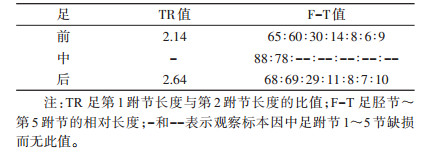扩展功能
文章信息
- 孟锦昕, 王静林, 刘国平
- MENG Jin-xin, WANG Jing-lin, LIU Guo-ping
- 纽结阿蠓雄虫的发现与描述(双翅目:蠓科)
- A newly found male Alluaudomyia desma Yu, 2005 (Diptera: Ceratopogonidae)
- 中国媒介生物学及控制杂志, 2023, 34(1): 114-116
- Chin J Vector Biol & Control, 2023, 34(1): 114-116
- 10.11853/j.issn.1003.8280.2023.01.021
-
文章历史
- 收稿日期: 2022-10-31
2 北部战区疾病预防控制中心, 辽宁 沈阳 110034
2 Center for Disease Control and Prevention of Northern Theater Command, Shenyang, Liaoning 110034, China
阿蠓属(Alluaudomyia)属于蠓科(Ceratopogonidae)蠓亚科(Ceratopogoninae),世界阿蠓属已知有201种[1],中国的阿蠓属现知有36种[2-6]。纽结阿蠓(All. deama Yu,2005)[2]原描述仅依据雌虫标本,无雄虫信息。作者在鉴定整理采自西藏自治区(西藏)错那县的蠓类标本中发现了纽结阿蠓雄虫,为了完善该蠓种雌、雄标本的分类资料,对今后该蠓种的分类鉴定提供更充足的依据,现将纽结阿蠓雄虫描述如下。
1 材料与方法1988年5-9月在西藏错那县勒乡选择牛舍和居住区,采用紫外光诱虫灯诱法收集蠓标本。将采获的蠓放置70%的乙醇溶液保存,记录相关采集信息。采用加拿大树胶酚封片法制作玻片标本,进行分类鉴定。
2 结果纽结阿蠓Alluaudomyia desma Yu,2005(图 1)

|
| 注:a触角端部5节(apical 5 segment of antenna);b触须(maxillary palpi);c翅(wing);d各足股节–胫节(femera and tibiae of legs),d-f(前足),d-m(中足),d-h(后足);e阳基侧突(parameres);f前足跗节V(fat V);g额部(frons);h尾器(hypopygium)。 图 1 纽结阿蠓(雄虫) Figure 1 Alluaudomyia desma Yu, 2005(♂) |
| |
Alluaudomyia desma Yu,2005:1346,中国(西藏)(♀)[2]
鉴别特征:两复眼的小眼面间有柔毛,翅径中横脉和径2室端部各有1个暗斑,尾器第9背板后缘中部有1对角突,阳茎中叶端部呈1对指状突,阳基侧突细杆状,基部有2对钩状弯曲,端部侧弯曲。
雄虫
翅长0.88 mm,宽0.34 mm,前缘脉比(CR,前缘脉与翅长之比)0.42。
头部:两复眼的小眼面间有柔毛。触角各鞭节的相对长度为30∶14∶14∶12∶10∶10∶13∶13∶13∶17∶31∶30∶31。触须第1~5节的相对长度为5∶9∶14∶13∶13,第3节近端部有1个椭圆形的感觉器窝,触须比(PR,触须第3节的长度与其宽度的比值)2.80。
胸部:翅淡色,翅径中横脉和径2室端部各有1个暗斑,翅面大毛见于近端部1/4和径5室前缘。足棕褐色,前足股节、胫节基部和近端部各有2个淡环;中足近基部3/4淡色,亚端部有1个淡环,胫节近基部和近端部各有1个淡环;后足股节、胫节基部和近端部各有2个淡环,后足胫节端部长鬃6根,第2根最长。各足TR(足第1跗节长度与第2跗节长度的比值)和F-T(足胫节~第5跗节的相对长度)值见表 1。
腹部:尾器第9腹板后缘弧形宽凹,膜无微毛;第9背板基部宽,向端部逐渐变窄,后缘中部有1对角状突;抱器基节略细长,背踝、腹踝缺如,端节细长略弯曲;阳茎中叶近锥形,端部呈1对指状突,阳茎拱高约为阳茎中叶总长的1/3;阳基侧突分离,呈细长的杆状,基部有2对钩状弯曲,端部侧弯曲。
观察标本:1♂,1988年9月采自西藏错那县,灯光诱获。标本保存于北部战区疾病预防控制中心。
3 讨论纽结阿蠓依据1988年9月采自西藏错那县勒乡的1♀标本建立。本文描述1♂标本,1988年9月采自西藏错那县,为该种模式产地相同时间采集。基本特征:两复眼的小眼面间有柔毛,翅径中横脉和径2室端部各有1个暗斑,各足股节和胫节基部和近端部有淡环,与原描述雌虫模式标本一致;第8腹节腹面无纽结状角质增厚斑,与雌性正模不同,应为雌性第8腹节为生殖节特化所致。结合形态特征、采集地点和时间,因此鉴定为纽结阿蠓,补充了原定种所缺乏的重要的雄虫信息。纽结阿蠓属于阿蠓属纽结阿蠓种团desma group(Yu,2005),现知1种。该种翅的形态与龙州阿蠓(All. longzhouensis Hao et Yu,1991)[2]和淡黄阿蠓[All. xanthocoma(Kieffer,1913)][7]相近似,但龙州阿蠓和淡黄阿蠓雄虫尾器第9背板、阳茎中叶和阳基侧突的形态特征与纽结阿蠓明显不同。
利益冲突 无
| [1] |
Borkent A, Dominiak P. Catalog of the biting midges of the world (Diptera: Ceratopogonidae)[J]. Zootaxa, 2020, 4787(1): 1-377. DOI:10.11646/zootaxa.4787.1.1 |
| [2] |
虞以新, 刘金华, 刘国平, 等. 中国蠓科昆虫. 昆虫纲(双翅目)第2卷[M]. 北京: 军事医学科学出版社, 2006: 1344-1384. Yu YX, Liu JH, Liu GP, et al. Ceratopogonidae of China (Insecta: Diptera). Vol. Ⅱ.[M]. Beijing: Military Medical Science Press, 2006: 1344-1384. |
| [3] |
刘仰青, 柳小青, 虞以新. 江西省阿蠓属一新种(双翅目: 蠓科)[J]. 中国媒介生物学及控制杂志, 2011, 22(4): 364-365. Liu YQ, Liu XQ, Yu YX. A new species of Alluaudomyia (Diptera: Ceratopogonidae) from Jiangxi province, China[J]. Chin J Vector Biol Control, 2011, 22(4): 364-365. |
| [4] |
杨定, 李竹, 刘启飞. 中国生物物种名录第二卷动物昆虫(V)[M]. 北京: 科学出版社, 2020: 119-221. Yang D, Li Z, Liu QF. Species catalogue of China: Volume 2 Animals Insecta (V)[M]. Beijing: Science Press, 2020: 119-221. |
| [5] |
Wu XX, He ZH, Lin XD, et al. Three new species of the genus Alluaudomyia kieffer, 1913(Diptera: Ceratopogonidae) from the National Park of Hainan Tropical Rainforest, China[J]. Zookeys, 2022, 1112(3): 199-218. DOI:10.3897/zookeys.1112.83021 |
| [6] |
吴小香, 杨浩, 孟祥瑞, 等. 阿蠓属一新种及一中国新记录种(昆虫纲: 双翅目: 蠓科)[J]. 环境昆虫学报, 2022, 44(4): 1043-1052. Wu XX, Yang H, Meng XR, et al. A new species and a newly recorded species of the genus Alluaudomyia (Insecta: Diptera: Ceratopogonidae) from China[J]. J Environ Entomol, 2022, 44(4): 1043-1052. DOI:10.3969/j.issn.1674-0858.2022.04.30 |
| [7] |
Keiffer JJ. Ⅷ. Nouvelle etude sur les chironomides de l'Indian Museum de Calcutta[J]. Rec Indian Mus, 1913, 9: 119-197. |
 2023, Vol. 34
2023, Vol. 34



